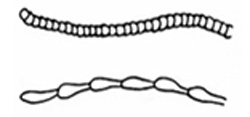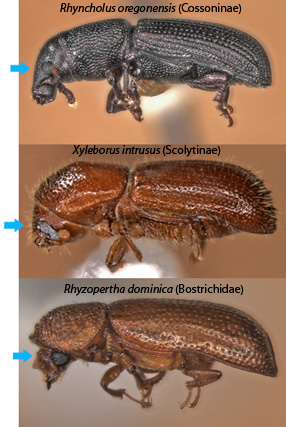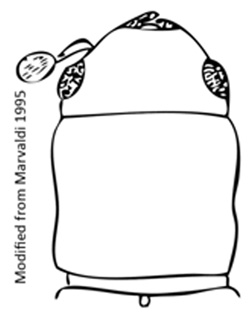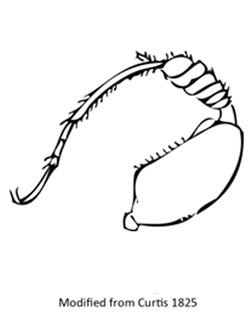The "true" bark beetles belong to the subfamily Scolytinae within the family Curculionidae. Although some genera within the group are referred to as ambrosia beetles due to their feeding habits, all references in this tool include the bark- and fungus-feeding insects grouped under this subfamily. Identifying bark beetles can be quite challenging, particularly since there are a number of other wood boring and phloem inhabiting beetles that resemble them.
Bark beetles look round in a frontal view; as a result, their exit holes from their hosts are round as well. Usually, these holes are about one millimeter or less in diameter, unlike those of other larger wood infesting beetles, including long horned beetles (Cerambycidae) and metallic wood boring beetles (Buprestidae). However, other similarly sized Coleoptera also leave behind a round exit hole on their hosts.
Some of the most similar groups of beetles to the scolytids are, of course, those in their own family, the Curculionidae; some examples are the cossonine weevils (Cossoninae) and the pinhole bark borers (Platypodinae). Members of other families can also appear very similar to bark beetles, such as the horned powderpost beetles (Bostrichidae), and can be confusing to the untrained eye. Go through the following information about the family and learn tips in how to separate the Scolytinae from other similar groups.
The following combination of characters is useful in distinguishing curculionids from other similar groups of Coleoptera.


Within the Curculionidae, the subfamily Scolytinae shares the wood boring habit with the subfamilies Cossoninae and Platypodinae. While these subfamilies all look quite similar, they may be differentiated by a few simple characters.
Bark beetles can be distinguished from the Cossoninae by having an elongated, oval-shaped eyed instead of a rounded eye and almost no indication of a rostrum (Fig. 3). Cossonines have a very short rostrum (Fig. 3 top); they also have a fairly narrow clubclub:
the apical segment of the insect antennae that is enlarged or thickened such that it is anatomically differentiated from the preceding segments
which is distinguishably wider in the Scolytinae. Among other more difficult characters, the fore tibiatibia:
the fourth division of an insect's leg, between the femur and the tarsus
of cossonines possesses a distinct comb on the apicalapical:
situated at the apex or extreme outer edge of a structure or appendage
edge.

Both Platypodinae and Scolytinae lack a rostrum almost completely. The most visible contrasting character is the convex, round eye of the Platypodinae (Fig. 4) and the Scolytinae's flat, elongated, oval-shaped eye. In addition, they differ in the general proportion of the body, Platypodinae having a much more elongated prothorax than the Scolytinae (Fig. 4). Perhaps the most distinguishing character of the Platypodinae is the elongated tarsus (Fig. 5), which is considerably longer than their tibiatibia:
the fourth division of an insect's leg, between the femur and the tarsus
; this is not the case in the Scolytinae.

